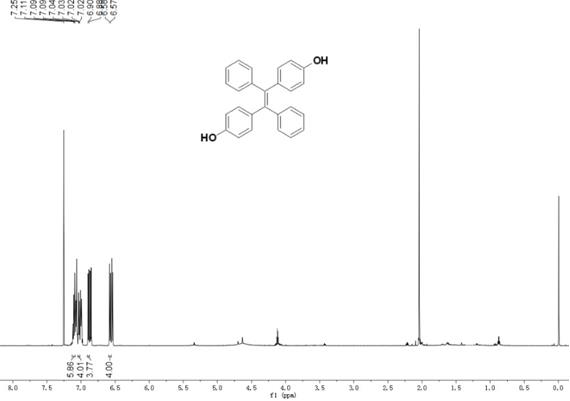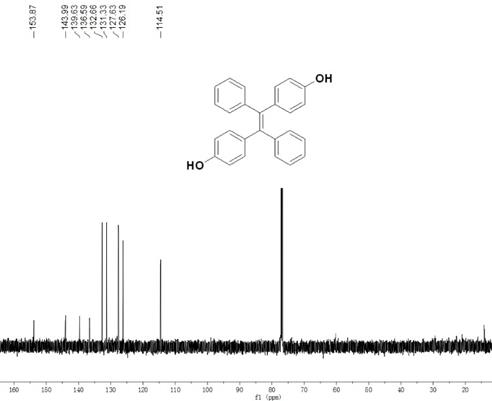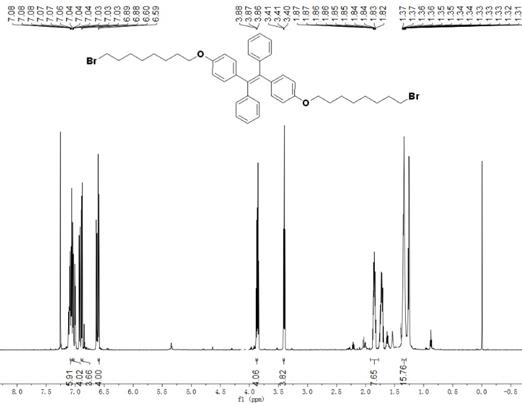Zinc ion fluorescent probe based on tetraphenyl ethylene as well as preparation method and application thereof
A fluorescent probe, tetraphenylethylene technology, used in fluorescence/phosphorescence, chemical instruments and methods, luminescent materials, etc.
- Summary
- Abstract
- Description
- Claims
- Application Information
AI Technical Summary
Problems solved by technology
Method used
Image
Examples
Embodiment 1
[0057] Example 1 Preparation of zinc ion fluorescent probe based on tetraphenylethylene
[0058] (1) Preparation of TPE-2OH: Dissolve 4-hydroxybenzophenone (1.98 g, 1 mmol) in 100 mL of anhydrous tetrahydrofuran, add zinc powder (3.45 g, 0.5 mmol), vacuumize and replace with nitrogen The whole reaction process was carried out under a nitrogen atmosphere three times, and then TiCl4 (2.8mL) was slowly added dropwise in an ice-water bath, and after stirring for 30 min, the entire device under vacuum was moved to an oil bath. The reaction was refluxed at ℃ for 24 hours, then the reaction was cooled to room temperature, and K was added under vigorous stirring. 2 CO 3 Aqueous solution (20 mL, 10%) was used to quench the reaction. with CH 2 Cl 2 The organic phase was separated by extraction, and the combined organic phase was washed with anhydrous Na 2 SO 4dry. The organic layer was evaporated by rotary evaporation, and the obtained crude product was purified by silica gel co...
Embodiment 2
[0067] Example 2 TPE-3N to Zn 2+ selectivity
[0068] DMSO / tris-HCL buffer solution in 100 μL TPE-3N (DMSO / tris-HCL buffer solution=1:1, v / v, pH=7.4, c=1×10 -5 M), add 1mL K + , Fe 3+ , Mn 2+ 、Ni + 、Cr 3+ 、Cd 2+ , Ca 2+ , Hg 2+ 、Cu 2+ 、Ag + , Pd 2+ 、Co 2+ and Zn 2+ (c=1×10 -3 M) aqueous solution, if the fluorescence intensity of TPE-3N is significantly enhanced, Zn is added 2+ , if the fluorescence intensity of TPE-3N does not change significantly, other metal ions are added.
Embodiment 3
[0069] Example 3 Cytotoxicity Test
[0070] Firstly, HeLa cells growing in logarithmic phase were inoculated into DMEM medium containing 10% fetal bovine serum, and incubated at 37°C for 24 hours. Add 100 μL of different concentrations of TPE-3N (0 μg / mL, 5 μg / mL, 10 μg / mL, 25 μg / mL, 50 μg / mL, 100 μg / mL) to each well in turn, and then contain 5 %CO 2 After 48 hours, all the culture medium was sucked off, and then washed three times with PBS buffer solution (100mM, pH=7.4). After adding 100 μL of cell culture medium to each well, continue to add MTT solution and incubate for 4 h. Add 100 μL of DMSO to dissolve the formazan crystals, and measure the absorbance in a microplate reader. Such as Figure 15 , after HeLa cells were incubated in different concentrations of TPE-3N solutions, the survival rate of the cells reached more than 85%. The experimental results showed that TPE-3N has low toxicity and good biocompatibility, which is suitable for fluorescence imaging of cancer...
PUM
 Login to View More
Login to View More Abstract
Description
Claims
Application Information
 Login to View More
Login to View More - R&D
- Intellectual Property
- Life Sciences
- Materials
- Tech Scout
- Unparalleled Data Quality
- Higher Quality Content
- 60% Fewer Hallucinations
Browse by: Latest US Patents, China's latest patents, Technical Efficacy Thesaurus, Application Domain, Technology Topic, Popular Technical Reports.
© 2025 PatSnap. All rights reserved.Legal|Privacy policy|Modern Slavery Act Transparency Statement|Sitemap|About US| Contact US: help@patsnap.com



